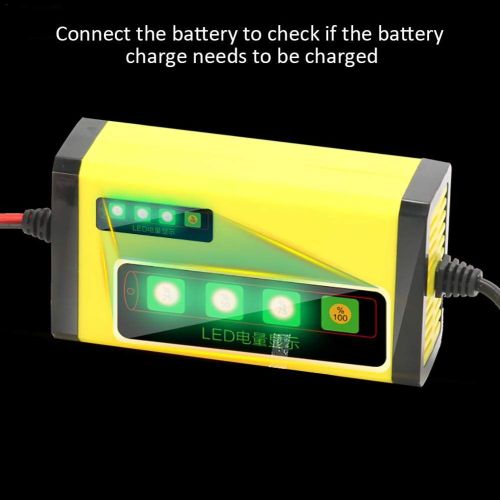In a motorcycle, it is the the battery that provides a massive shot of voltage / current to the starter motor in order to turn the engine over and start the internal combusion engine process.
This is typicall called "battery cranking power". A healthy battery can provide several shots of cranking power. Depending on how bad it is, an unhealthy battery can provide some, sometimes even none. This is called a flat or dead battery.
Batteries lose their charge over time, and the VT250CR had been sitting in the bushes for a few years, exposed to the elements, so my guess was that it's battery was flat.
So I bought a battery charger on Carousell, a local Hong Kong Buy & Sell website, for HKD100, or about USD12.50. Of course, it came without any instructions in English:
Here's what I got:
Description:
Here's what the unit looked like and some of its associated images:
Specifications:
Vendor Provided Instructions:
Proper Instructions:
I'm not really keen on battery charger instructions that just say:
"automatically stop when fully charged, no need to care"
Especially when it comes to high-current, no-name products.
So, for anyone who has ever bought a SHENGXIANG 12V 2A Battery Charger, I thought I'd provide some proper instructions in English, so here you are:
Method:
02. With the charger unplugged, connect the BLACK clamp to the NEGATIVE pole of the battery (-).
03. With the charger unplugged, connect the RED clamp to the POSITIVE pole of the battery (+).
Your setup should resemble this:
04. Turn the charger on and inspect the charger interface to make sure there's no fault light illuminated. If there is a fault light, unplug the charger!
05. Use a multimeter to directly measure the voltage coming out of the charger when it is under load: The value should be ~15VDC.
06. With no fault lights illuminated, let the battery charge in a well-ventilated place for about 10 minutes.
07. Turn off the charger.
08. Measure what the battery is putting out after a 10 minute charging session:
I got 5.26VDC but you may get a diffferent value, which is not that important because we are using this measurement to establishing a baseline reference value. What really matters is that the next measurement will demonstrate that battery voltage is increasing, which is what we want.
09. Turn the charger back on.
10. Leave the battery on charge for 1 more hour.
12. Turn off the charger.
13. Measure what the battery is putting out:
I got 7.62VDC but you may get a diffferent value. What matters is that the value is going up.
14. Turn the charger back on.
12. Turn off the charger.
13. Measure what the battery is putting out:
14. Repeat the off-measure-on process
010 minutes: 4.98VDC
070 minutes: 6.95VDC
130 minutes:
190 minutes:
In the end, my motorcycle battery charged up to 12.6VDC, and was able to hold its charge for several hours, which is exactly how a motorcyle battery should behave.
https://www.amazon.com/Bulary-Battery-Portable-Maintain-Damaging/dp/B07MKNG9GR
https://www.autobatteries.com/en-us/battery-testing-and-maintenance/car-battery-voltage-and-testing
VT250CR - How to Use a SHENGXIANG 12v 2A Motorcycle Battery Charger
04. Turn the charger on and inspect the charger interface to make sure there's no fault light illuminated. If there is a fault light, unplug the charger!
05. Use a multimeter to directly measure the voltage coming out of the charger when it is under load: The value should be ~15VDC.
07. Turn off the charger.
I got 5.26VDC but you may get a diffferent value, which is not that important because we are using this measurement to establishing a baseline reference value. What really matters is that the next measurement will demonstrate that battery voltage is increasing, which is what we want.
09. Turn the charger back on.
10. Leave the battery on charge for 1 more hour.
12. Turn off the charger.
13. Measure what the battery is putting out:
I got 7.62VDC but you may get a diffferent value. What matters is that the value is going up.
14. Turn the charger back on.
15. Leave the battery on charge for 1 more hour.
12. Turn off the charger.
I got 7.82VDC but you may get a diffferent value. What matters is that the value is going up.
14. Repeat the off-measure-on process
14. If your voltage is what it should be (12.6VDC), disconnect the charger from the battery.
15. Wait for a total of 190 minutes (60 more, 130 have already passed).
At this point, the battery should be putting out ~12.6VDC.
15. Wait for a total of 190 minutes (60 more, 130 have already passed).
16. Measure what the battery is putting out:
17. Wait for a total of 250 minutes (60 more, 190 have already passed).
18. Measure what the battery is putting out:
At this point, the battery should be putting out ~12.6VDC.
Here's the readings I got:
010 minutes: 4.98VDC
070 minutes: 6.95VDC
130 minutes:
190 minutes:
250 minutes:
Conclusion:
REFERENCES:
https://www.gnbsystems.com/faq.phphttps://www.amazon.com/Bulary-Battery-Portable-Maintain-Damaging/dp/B07MKNG9GR
https://www.autobatteries.com/en-us/battery-testing-and-maintenance/car-battery-voltage-and-testing
VT250CR - How to Use a SHENGXIANG 12v 2A Motorcycle Battery Charger









No comments:
Post a Comment